Brussels-South railway station
Brussels-South (French: Bruxelles-Midi, Dutch: Brussel-Zuid, IATA code: ZYR) is one of the three major railway stations in Brussels (the other two are Brussels-Central and Brussels-North) and the busiest station in Belgium. It is located on the territory of the municipality of Saint-Gilles/Sint-Gillis. The station is connected to the Gare du Midi/Zuidstation station of the Brussels metro system.
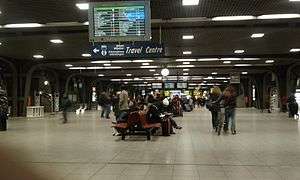 Main hall of Brussels-South railway station | ||||||||||||||||||||||||||||||||||||||||||||||||||||||||||||||||||||||||||||||||||||||||||||||||||||||||||||||||||||||||||||||||||||||||||||||||||||||||||||||||||||||||||||||||||||||||||||||||||||||||||||||||||||||||||||||
| Location | Avenue Fonsny / Fonsnylaan 47B B-1060 Saint-Gilles, Brussels-Capital Region | |||||||||||||||||||||||||||||||||||||||||||||||||||||||||||||||||||||||||||||||||||||||||||||||||||||||||||||||||||||||||||||||||||||||||||||||||||||||||||||||||||||||||||||||||||||||||||||||||||||||||||||||||||||||||||||
| Coordinates | 50.835161°N 4.335222°E | |||||||||||||||||||||||||||||||||||||||||||||||||||||||||||||||||||||||||||||||||||||||||||||||||||||||||||||||||||||||||||||||||||||||||||||||||||||||||||||||||||||||||||||||||||||||||||||||||||||||||||||||||||||||||||||
| Elevation | 26 m (85 ft) | |||||||||||||||||||||||||||||||||||||||||||||||||||||||||||||||||||||||||||||||||||||||||||||||||||||||||||||||||||||||||||||||||||||||||||||||||||||||||||||||||||||||||||||||||||||||||||||||||||||||||||||||||||||||||||||
| Owned by | SNCB/NMBS | |||||||||||||||||||||||||||||||||||||||||||||||||||||||||||||||||||||||||||||||||||||||||||||||||||||||||||||||||||||||||||||||||||||||||||||||||||||||||||||||||||||||||||||||||||||||||||||||||||||||||||||||||||||||||||||
| Operated by | SNCB/NMBS | |||||||||||||||||||||||||||||||||||||||||||||||||||||||||||||||||||||||||||||||||||||||||||||||||||||||||||||||||||||||||||||||||||||||||||||||||||||||||||||||||||||||||||||||||||||||||||||||||||||||||||||||||||||||||||||
| Line(s) | 0, 50A, 96, 124 | |||||||||||||||||||||||||||||||||||||||||||||||||||||||||||||||||||||||||||||||||||||||||||||||||||||||||||||||||||||||||||||||||||||||||||||||||||||||||||||||||||||||||||||||||||||||||||||||||||||||||||||||||||||||||||||
| Platforms | 12 | |||||||||||||||||||||||||||||||||||||||||||||||||||||||||||||||||||||||||||||||||||||||||||||||||||||||||||||||||||||||||||||||||||||||||||||||||||||||||||||||||||||||||||||||||||||||||||||||||||||||||||||||||||||||||||||
| Tracks | 22 | |||||||||||||||||||||||||||||||||||||||||||||||||||||||||||||||||||||||||||||||||||||||||||||||||||||||||||||||||||||||||||||||||||||||||||||||||||||||||||||||||||||||||||||||||||||||||||||||||||||||||||||||||||||||||||||
| Construction | ||||||||||||||||||||||||||||||||||||||||||||||||||||||||||||||||||||||||||||||||||||||||||||||||||||||||||||||||||||||||||||||||||||||||||||||||||||||||||||||||||||||||||||||||||||||||||||||||||||||||||||||||||||||||||||||
| Architect | Adrien Blomme, Yvan Blomme and Fernand Petit | |||||||||||||||||||||||||||||||||||||||||||||||||||||||||||||||||||||||||||||||||||||||||||||||||||||||||||||||||||||||||||||||||||||||||||||||||||||||||||||||||||||||||||||||||||||||||||||||||||||||||||||||||||||||||||||
| Architectural style | Modernism | |||||||||||||||||||||||||||||||||||||||||||||||||||||||||||||||||||||||||||||||||||||||||||||||||||||||||||||||||||||||||||||||||||||||||||||||||||||||||||||||||||||||||||||||||||||||||||||||||||||||||||||||||||||||||||||
| Other information | ||||||||||||||||||||||||||||||||||||||||||||||||||||||||||||||||||||||||||||||||||||||||||||||||||||||||||||||||||||||||||||||||||||||||||||||||||||||||||||||||||||||||||||||||||||||||||||||||||||||||||||||||||||||||||||||
| Station code | FBMZ | |||||||||||||||||||||||||||||||||||||||||||||||||||||||||||||||||||||||||||||||||||||||||||||||||||||||||||||||||||||||||||||||||||||||||||||||||||||||||||||||||||||||||||||||||||||||||||||||||||||||||||||||||||||||||||||
| Website | Official website | |||||||||||||||||||||||||||||||||||||||||||||||||||||||||||||||||||||||||||||||||||||||||||||||||||||||||||||||||||||||||||||||||||||||||||||||||||||||||||||||||||||||||||||||||||||||||||||||||||||||||||||||||||||||||||||
| History | ||||||||||||||||||||||||||||||||||||||||||||||||||||||||||||||||||||||||||||||||||||||||||||||||||||||||||||||||||||||||||||||||||||||||||||||||||||||||||||||||||||||||||||||||||||||||||||||||||||||||||||||||||||||||||||||
| Opened | 1952 | |||||||||||||||||||||||||||||||||||||||||||||||||||||||||||||||||||||||||||||||||||||||||||||||||||||||||||||||||||||||||||||||||||||||||||||||||||||||||||||||||||||||||||||||||||||||||||||||||||||||||||||||||||||||||||||
| ||||||||||||||||||||||||||||||||||||||||||||||||||||||||||||||||||||||||||||||||||||||||||||||||||||||||||||||||||||||||||||||||||||||||||||||||||||||||||||||||||||||||||||||||||||||||||||||||||||||||||||||||||||||||||||||
| Location | ||||||||||||||||||||||||||||||||||||||||||||||||||||||||||||||||||||||||||||||||||||||||||||||||||||||||||||||||||||||||||||||||||||||||||||||||||||||||||||||||||||||||||||||||||||||||||||||||||||||||||||||||||||||||||||||
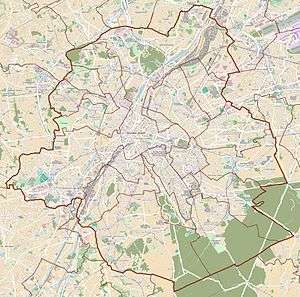 Brussels-South Location within Brussels | ||||||||||||||||||||||||||||||||||||||||||||||||||||||||||||||||||||||||||||||||||||||||||||||||||||||||||||||||||||||||||||||||||||||||||||||||||||||||||||||||||||||||||||||||||||||||||||||||||||||||||||||||||||||||||||||
Naming
The Brussels-Capital Region is bilingual; hence, both the French and Dutch names of the station are official. Outside Belgium, this often leads to the use of combined shorthands; for example in the Thomas Cook European Rail Timetable, Brussels-South is designated as Brussels Midi/Zuid; Dutch Railways announce the station as Brussel Zuid/Midi. "Le Midi" is a reference to Southern France, as trains departing from this station in the 19th century had the region as their final destination. The name Brussel-Zuid, as the Dutch translation of Bruxelles-Midi, was only introduced after the equality law of 1898.[1]
History
First station (1839–1869)
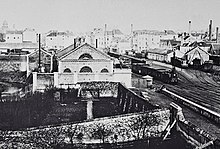
A first station known as Bogards' Station (French: Gare des Bogards, Dutch: Bogaardenstation) had existed, since 1839, near Rouppe Square in the southern part of the City of Brussels, so-called for the eponymous convent whose site it was built on, and to which Rue des Bogards/Bogaardenstraat is nowadays the only reference. The presence of a station at this location also explains the unusual width of the current Avenue of Stalingrad, which goes up from the square to the small ring road and back then used to have train tracks in the middle.[2]
Second station (1869–1949)
The Belgian railway network grew rapidly during the second half of the 19th century, and the old station quickly became too small, so the authorities decided to demolish it. A new monumental station built outside the Pentagon and designed by architect Auguste Payen opened in 1869, a short distance south from the original site.[2] In tribute to the railway technology, a statue of Nike, the Greek goddess of victory, was placed on the roof of the station.[1] In front of the station, a large square, known as the Place de la Constitution/Grondwetplein ("Constitution Square"), was created, acting as an entry to the city.[2][3]
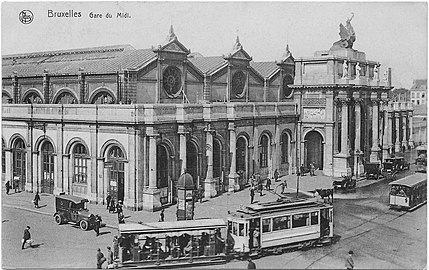 The second station (1869), pictured in 1927
The second station (1869), pictured in 1927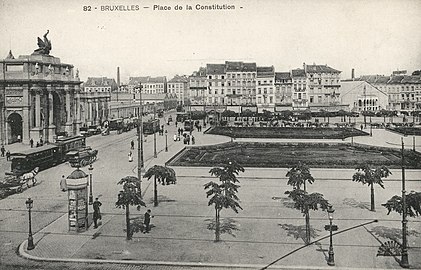 The Place de la Constitution/Grondwetplein in front of the second station
The Place de la Constitution/Grondwetplein in front of the second station
Third station (1949–present)
Payen's terminal station was itself demolished in 1949, as part of the North–South connection project, and replaced by a transit station on its present site along Avenue Fonsny/Fonsnylaan. Most of the current buildings were erected between 1939 and 1954, in post-war functionalist style, from plans by architects Adrien and Yvan Blomme and Fernand Petit. Work on the connection also led to the station's immediate surroundings to be reorganised. The tracks were raised 6 metres (20 feet) and extended unto a viaduct towards the city centre, with shops under it and a covered street, Rue Couverte/Bedektestraat (formerly Rue de l'Argonne/Argonnestraat), along which trams run.[2]
The rear part of the station, built in front of Victor Horta Square, and designed in 1992 by architect Marc De Vreese, serves as a terminal for high-speed trains.
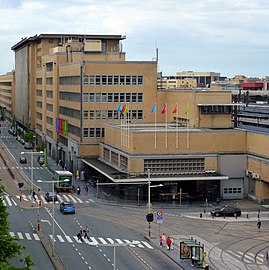 The third (current) station (1952) on Avenue Fonsny/Fonsnylaan
The third (current) station (1952) on Avenue Fonsny/Fonsnylaan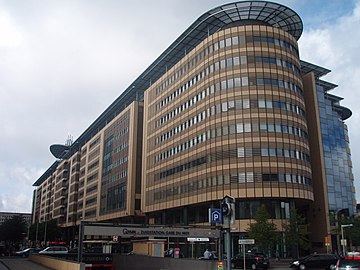 Terminal building (1992) on Victor Horta Square
Terminal building (1992) on Victor Horta Square.jpg) Station entrance
Station entrance
Features
The station is surrounded by Avenue Fonsny/Fonsnylaan to the east, Rue de France/Frankrijkstraat to the west, Rue Couverte/Bedektestraat to the north and Rue des Vétérinaires/Veeartsenstraat to the south. In the 1990s, the Eurostar terminal was added on Rue de France's side. This part contains two bay platforms with no onward northbound connection.
A tripartite agreement was signed by Belgium, France and the UK on 15 May 1993, which permitted British officials to carry out pre-embarkation immigration controls for passengers travelling on direct Eurostar train services from Brussels to London and Belgian officials to carry out pre-embarkation immigration controls at London Waterloo International station for passengers travelling in the other direction. As a result of this agreement, juxtaposed controls were set up in the station. On 1 October 2004, an administrative arrangement was signed by Belgium, France and the UK to extend juxtaposed controls to Eurostar services between London and Brussels which make a stop in Lille.[4]
Eurostar passengers travelling to the UK clear exit checks from the Schengen Area (carried out by the Belgian Federal Police) as well as UK entry checks (conducted by the UK Border Force) in the station before boarding their train. On the other hand, Eurostar passengers travelling to Lille Europe or Calais-Fréthun remain within the Schengen Area and are therefore not subject to border checks. Accordingly, they go through a different departure area in the station (bypassing the juxtaposed controls for passengers heading to the UK) and travel in a separate designated coach (available in standard class only) controlled by security guards, who ensure that all of these passengers disembark at Lille/Calais before the train continues to the UK.[5]
Train services
The station is served by the following services:
- High speed services (Eurostar) London - Calais - Lille - Brussels
- High speed services (Eurostar) London - Brussels - Rotterdam - Amsterdam
- High speed services (Intercity Express) Brussels - Liège - Cologne - Frankfurt
- High speed services (Thalys) Amsterdam - Rotterdam - Antwerp - Brussels - Paris
- High speed services (Thalys) Dortmund - Essen - Düsseldorf - Cologne - Liège - Brussels - Paris
- High speed services (Thalys) Amsterdam - Rotterdam - Antwerp - Brussels - Lille
- High speed services (Thalys) Amsterdam - Rotterdam - Antwerp - Brussels - Chambéry - Bourg-Saint-Maurice (in winter)
- High speed services (Thalys) Amsterdam - Rotterdam - Antwerp - Brussels - Avignon - Marseille (in summer)
- High speed services (TGV) Brussels - Lille - Aéroport CDG - Lyon - Avignon - Marseille
- High speed services (TGV) Brussels - Lille - Aéroport CDG - Lyon - Nîmes - Montpellier - Perpignan
- High speed services (TGV) Brussels - Lille - Aéroport CDG - Strasbourg
- High speed services (ICD-35) Amsterdam - Rotterdam - Breda - Antwerp - Brussels Airport - Brussels
- Intercity services (IC-16) Brussels - Namur - Arlon - Luxembourg
- Intercity services (IC-01) Ostend - Bruges - Ghent - Brussels - Leuven - Liège - Welkenraedt - Eupen
- Intercity services (IC-03) Knokke/Blankenberge - Bruges - Ghent - Brussels - Leuven - Hasselt - Genk
- Intercity services (IC-05) Antwerp - Mechelen - Brussels - Nivelles - Charleroi (weekdays)
- Intercity services (IC-06) Tournai - Ath - Halle - Brussels - Brussels Airport
- Intercity services (IC-06A) Mons - Braine-le-Comte - Brussels - Brussels Airport
- Intercity services (IC-11) Binche - Braine-le-Comte - Halle - Brussels - Mechelen - Turnhout (weekdays)
- Intercity services (IC-12) Kortrijk - Ghent - Brussels - Leuven - Liège - Welkenraedt (weekdays)
- Intercity services (IC-14) Quiévrain - Mons - Braine-le-Comte - Brussels - Leuven - Liège (weekdays)
- Intercity services (IC-17) Brussels - Namur - Dinant (weekends)
- Intercity services (IC-18) Brussels - Namur - Liège (weekdays)
- Intercity services (IC-20) Ghent - Aalst - Brussels - Hasselt - Tongeren (weekdays)
- Intercity services (IC-20) Ghent - Aalst - Brussels - Dendermonde - Lokeren (weekends)
- Intercity services (IC-22) Essen - Antwerp - Mechelen - Brussels (weekdays)
- Intercity services (IC-22) Antwerp - Mechelen - Brussels - Halle - Braine-le-Comte - Binche (weekends)
- Intercity services (IC-23) Ostend - Bruges - Kortrijk - Zottegem - Brussels - Brussels Airport
- Intercity services (IC-23A) Bruges - Ghent - Brussels - Brussels Airport (weekdays)
- Intercity services (IC-23A) Ghent - Brussels - Brussels Airport (weekends)
- Intercity services (IC-26) Kortrijk - Tournai - Halle - Brussels - Dendermonde - Lokeren - Sint Niklaas (weekdays)
- Intercity services (IC-29) De Panne - Gent - Aalst - Brussels - Brussels Airport - Leuven - Landen
- Intercity services (IC-31) Antwerp - Mechelen - Brussels (weekdays)
- Intercity services (IC-31) Antwerp - Mechelen - Brussels - Nivelles - Charleroi (weekends)
- Brussels RER services (S1) Antwerp - Mechelen - Brussels - Waterloo - Nivelles (weekdays)
- Brussels RER services (S1) Antwerp - Mechelen - Brussels (weekends)
- Brussels RER services (S1) Brussels - Waterloo - Nivelles (weekends)
- Brussels RER services (S2) Leuven - Brussels - Halle - Braine-le-Comte
- Brussels RER services (S3) Dendermonde - Brussels - Denderleeuw - Zottegem - Oudenaarde (weekdays)
- Brussels RER services (S6) Aalst - Denderleeuw - Geraardsbergen - Halle - Brussels - Schaarbeek
- Brussels RER services (S8) Brussels - Etterbeek - Ottignies - Louvain-le-Neuve
- Brussels RER services (S10) Dendermonde - Brussels - Denderleeuw - Aalst
Metro and premetro station
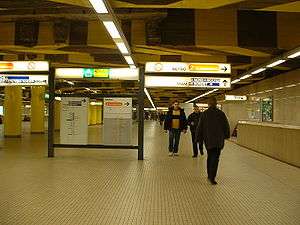 Gare du Midi/Zuidstation metro station | |||||||||||||||
| Owned by | STIB/MIVB | ||||||||||||||
| Connections | |||||||||||||||
| History | |||||||||||||||
| Opened | 2 October 1988 | ||||||||||||||
| Services | |||||||||||||||
| |||||||||||||||
The metro station, called Gare du Midi/Zuidstation, opened on 2 October 1988 as (at that time) the terminus of metro line 2 from Simonis. Line 2 has since been extended beyond Brussels-South to Clemenceau in 1993, Delacroix in 2006, and Gare de l'Ouest/Weststation in 2009. Since 1993, the station also accommodates premetro (underground tram) services at separate platforms, with cross-platform interchange between metro and premetro in both directions.
Ouibus
Since 23 July 2012, SNCF's international coach network, OUIBUS, has served Brussels South.
- Paris - Lille - Brussels
- Amsterdam - Brussels (from 28 April 2014)
- Amsterdam - Brussels - London (from 28 April 2014)
Other bus services
A shuttle service to Brussels South Charleroi Airport leaves from a stop located on Rue de France/Frankrijkstraat.[6]
Places of interest
The South Tower, the tallest building in Belgium,[7] stands in front of the station's main exit (the crossroad of Avenue Fonsny/Fonsnylaan and Rue Couverte/Bedektestraat) and houses the Belgian Federal Pensions Service (FPS).[8]
References
- focusonbelgium.be
- "A history of the development of the Gare du Midi district". be.midi. Retrieved 28 June 2020.
- "Saint-Gilles - Place de la Constitution". www.irismonument.be. Retrieved 28 June 2020.
- "Explanatory Memorandum to the Channel Tunnel (Miscellaneous Provisions) (Amendment) Order 2004 No. 2589" (PDF). Home Office.
- "Conditions of Carriage". Eurostar. 4 February 2019. Archived from the original on 27 March 2020. Retrieved 28 March 2020.
For security and border control reasons, any booking for intra-Schengen travel from Brussels to Lille or Calais is available in Standard class only and limited to coach 18 or 16 (the “Dedicated Coach”), depending on the type of train. Intra-Schengen passengers departing from Brussels are not subject to border controls, whether for exiting Schengen area or entering the United Kingdom. Therefore, any movement by any intra-Schengen passenger to and from the Dedicated Coach between Brussels and Lille or Calais will be strictly limited and controlled. You must cooperate with our on-board staff and agents, as well as security and border control authorities in the stations in relation to these requirements. Any failure to cooperate, any non-authorised movement to and from the Dedicated Coach and/or any refusal from any intra-Schengen passenger to get off the train at Lille or Calais may result in the intervention of security and border authorities
- Brussels City-Charleroi airport shuttle bus service
- GmbH, Emporis. "Belgium | Statistics | EMPORIS". www.emporis.com. Retrieved 23 March 2018.
- "SFPD". www.sfpd.fgov.be. Retrieved 23 March 2018.
External links
| Wikimedia Commons has media related to Brussels Midi station. |